#solar array size
Explore tagged Tumblr posts
Text
Why You Should Oversize Your Solar Array | Cedar Creek Energy
When considering solar energy for your home or business, one might naturally question the value of installing a solar array that exceeds your current energy needs. At Cedar Creek Energy, we advocate for the strategic benefits of oversizing your solar array, as it can lead to significant long-term advantages. Here’s why you should consider this approach and how understanding the DC-AC ratio and solar array size can make a difference.
Understanding the DC-AC Ratio
To grasp the benefits of an oversized solar array, it’s essential to understand the concept of the DC-AC ratio. Solar panels generate direct current (DC) electricity, which is then converted into alternating current (AC) by the solar inverter for use in your home or business. The DC-AC ratio refers to the proportion of the solar array size (DC) compared to the inverter’s capacity (AC).
An ideal DC-AC ratio is typically above 1.0, meaning the solar array generates more DC electricity than the inverter can convert to AC. This may seem counterintuitive—why generate more power than the inverter can handle? The reason lies in optimizing overall energy production. During peak sunlight hours, the array may produce more DC power than the inverter can convert, resulting in a phenomenon known as "clipping." However, this excess energy is not lost but rather managed to maximize production throughout the day.
The Benefits of an Oversized Solar Array
Maximizing Energy Production: By installing a larger solar array, you capture more sunlight, especially during the mornings and evenings when the sun is at a lower angle. While it’s true that some energy may be clipped during peak hours, the overall energy generated across the day is significantly higher. This is due to the larger array producing more energy during off-peak times when your inverter can fully utilize its capacity.
Compensating for Variability: Solar power is inherently variable. Factors like weather conditions, seasonal changes, and even shading can impact energy production. An oversized solar array helps mitigate these fluctuations by ensuring that even on less sunny days, you generate sufficient power to meet your needs. This added capacity provides a buffer against unpredictable energy losses and ensures a more consistent power supply.
Financial Incentives and Savings: Many financial incentives are available for solar energy systems, especially for businesses. Oversizing your solar array can qualify you for additional benefits such as the Federal Investment Tax Credit (ITC) and Production Tax Credit (PTC). Moreover, programs like Xcel Energy’s PV Demand Credit offer extra incentives for businesses that generate substantial amounts of solar power during peak demand hours. By oversizing your system, you can potentially reduce your reliance on grid electricity and lower your overall energy costs.
Long-Term Investment: Although an oversized solar array may involve a higher initial investment, the long-term savings and benefits often outweigh the costs. With greater energy production, you can enjoy reduced utility bills and a quicker return on your investment. Additionally, as energy prices rise, having a larger solar array provides financial stability and protection against future rate increases.
Enhanced System Performance: An oversized system generally operates more efficiently, as it can better handle variations in sunlight and energy demand. This enhanced performance ensures that your solar energy system continues to operate optimally, providing reliable power and maximizing your energy savings over time.
At Cedar Creek Energy, we specialize in designing solar installations that align with your specific needs and goals. By choosing to oversize your solar array, you’re making a strategic investment in your energy future. Our team can help you understand the DC-AC ratio, optimize your solar array size, and take full advantage of available incentives. Get in touch with us today to learn how we can tailor a solar solution that works best for you and your energy needs.
0 notes
Text
NASAs Europa Clipper Gets Set of Super-Size Solar Arrays
The largest spacecraft NASA has ever built for planetary exploration just got its ‘wings’ — massive solar arrays to power it on the journey to Jupiter’s icy moon Europa. NASA’s Europa Clipper spacecraft recently got outfitted with a set of enormous solar arrays at the agency’s Kennedy Space Center in Florida. Each measuring about 46½ […] from NASA https://ift.tt/R27wPqM
1 note
·
View note
Text
Exhaustive secondary research was done to collect information on the Satellite Solar Panels and Array Market, its adjacent markets, and its parent market. The next step was to validate these findings, assumptions, and sizing with industry experts across the value chain through primary research. Demand-side analyses were carried out to estimate the overall size of the market. Both, top-down and bottom-up approaches were employed to estimate the complete market size. Thereafter, market breakdown and data triangulation were used to estimate the size of segments and subsegments.
#Satellite Solar Panels And Array#Satellite Solar Panels And Array Market#Satellite Solar Panels And Array Industry#Global Satellite Solar Panels And Array Market#Satellite Solar Panels And Array Market Companies#Satellite Solar Panels And Array Market Size#Satellite Solar Panels And Array Market Share#Satellite Solar Panels And Array Market Growth#Satellite Solar Panels And Array Market Statistics
0 notes
Text
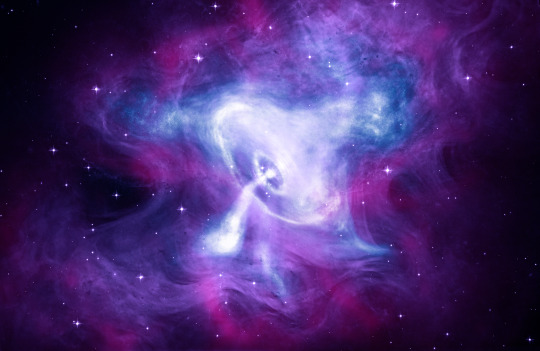
Navigating Deep Space by Starlight
On August 6, 1967, astrophysicist Jocelyn Bell Burnell noticed a blip in her radio telescope data. And then another. Eventually, Bell Burnell figured out that these blips, or pulses, were not from people or machines.

The blips were constant. There was something in space that was pulsing in a regular pattern, and Bell Burnell figured out that it was a pulsar: a rapidly spinning neutron star emitting beams of light. Neutron stars are superdense objects created when a massive star dies. Not only are they dense, but neutron stars can also spin really fast! Every star we observe spins, and due to a property called angular momentum, as a collapsing star gets smaller and denser, it spins faster. It’s like how ice skaters spin faster as they bring their arms closer to their bodies and make the space that they take up smaller.
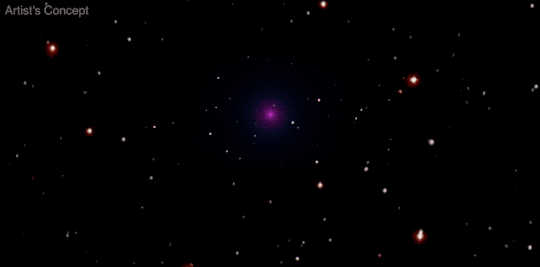
The pulses of light coming from these whirling stars are like the beacons spinning at the tops of lighthouses that help sailors safely approach the shore. As the pulsar spins, beams of radio waves (and other types of light) are swept out into the universe with each turn. The light appears and disappears from our view each time the star rotates.
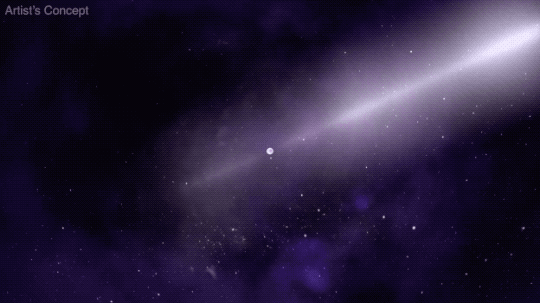
After decades of studying pulsars, astronomers wondered—could they serve as cosmic beacons to help future space explorers navigate the universe? To see if it could work, scientists needed to do some testing!
First, it was important to gather more data. NASA’s NICER, or Neutron star Interior Composition Explorer, is a telescope that was installed aboard the International Space Station in 2017. Its goal is to find out things about neutron stars like their sizes and densities, using an array of 56 special X-ray concentrators and sensitive detectors to capture and measure pulsars’ light.
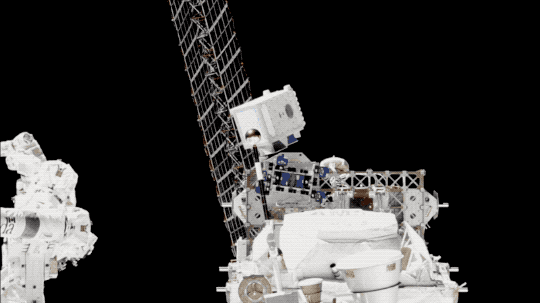
But how can we use these X-ray pulses as navigational tools? Enter SEXTANT, or Station Explorer for X-ray Timing and Navigation Technology. If NICER was your phone, SEXTANT would be like an app on it.
During the first few years of NICER’s observations, SEXTANT created an on-board navigation system using NICER’s pulsar data. It worked by measuring the consistent timing between each pulsar’s pulses to map a set of cosmic beacons.
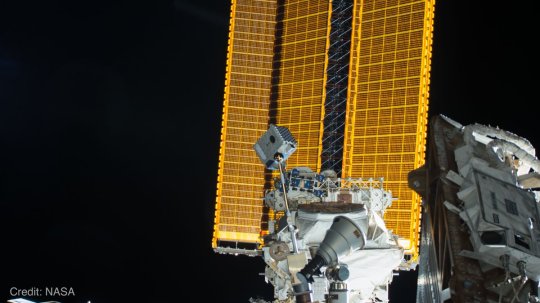
When calculating position or location, extremely accurate timekeeping is essential. We usually rely on atomic clocks, which use the predictable fluctuations of atoms to tick away the seconds. These atomic clocks can be located on the ground or in space, like the ones on GPS satellites. However, our GPS system only works on or close to Earth, and onboard atomic clocks can be expensive and heavy. Using pulsar observations instead could give us free and reliable “clocks” for navigation. During its experiment, SEXTANT was able to successfully determine the space station’s orbital position!
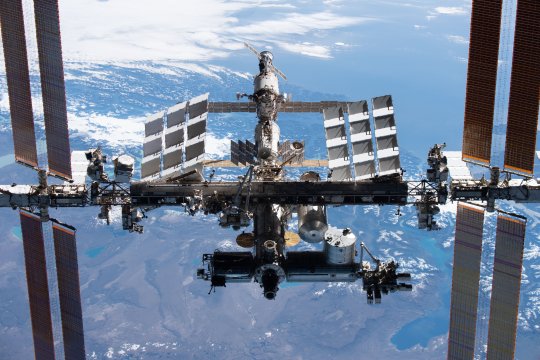
We can calculate distances using the time taken for a signal to travel between two objects to determine a spacecraft’s approximate location relative to those objects. However, we would need to observe more pulsars to pinpoint a more exact location of a spacecraft. As SEXTANT gathered signals from multiple pulsars, it could more accurately derive its position in space.
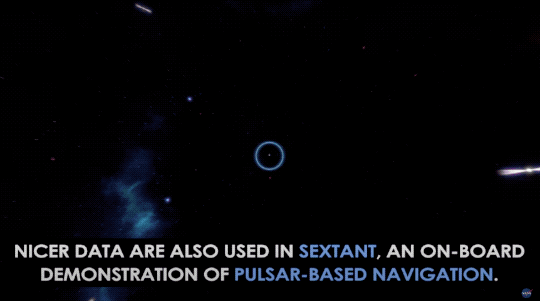
So, imagine you are an astronaut on a lengthy journey to the outer solar system. You could use the technology developed by SEXTANT to help plot your course. Since pulsars are reliable and consistent in their spins, you wouldn’t need Wi-Fi or cell service to figure out where you were in relation to your destination. The pulsar-based navigation data could even help you figure out your ETA!
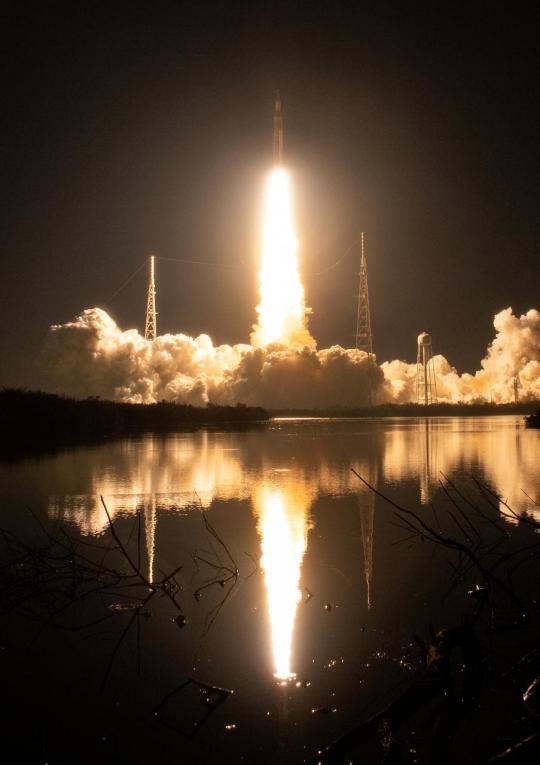
None of these missions or experiments would be possible without Jocelyn Bell Burnell’s keen eye for an odd spot in her radio data decades ago, which set the stage for the idea to use spinning neutron stars as a celestial GPS. Her contribution to the field of astrophysics laid the groundwork for research benefitting the people of the future, who yearn to sail amongst the stars.
Keep up with the latest NICER news by following NASA Universe on X and Facebook and check out the mission’s website. For more on space navigation, follow @NASASCaN on X or visit NASA’s Space Communications and Navigation website.
Make sure to follow us on Tumblr for your regular dose of space!
#NASA#pulsar#Jocelyn Bell Burnell#spaceblr#space#star#neutron star#deep space#telescope#navigation#universe#astronomy#science
4K notes
·
View notes
Text
A Brief Introduction to Planet Oa
Nestled in the very heart of the cosmos, at the center of Sector 0, the planet of Oa serves as both the homeworld of the Green Lantern Corps and a symbol of order for the universe at large.

Oa is one of the oldest planets in existence. Its parent star, Sto-Oa ("Light of Oa" in the Maltusian language) is a red hypergiant that formed shortly after the Big Bang. There are eleven planets in the star system (five terrestrial, three gas giants and four ice giants) most of which serve as farmland and resource mines.
Oa is the fourth closest to the star, and it takes approximately 574 Earth days to complete one revolution around its star. The planet is actually tidally locked in its orbit, meaning that it does not have a natural day-night cycle.
However, the Guardians of the Universe have constructed a massive ring of solar arrays that slowly revolves around the planet. The shadow cast by this megastructure simulates "night" by blocking out Oa's parent star from the hemisphere that it shines upon, while simultaneously refracting Sto-Oa's light to the far side to create an artificial "day."
(Would it have been more practical to simply force Oa to spin in its orbit? The Guardians are certainly powerful enough to induce planetary rotation. When asked why they chose this as a solution instead, they declined to comment.)
The Guardians chose to set the length of Oa's "day" equal to their ancestral home's, exactly twenty-and-a-half Earth hours. There are no seasons or months, as the planet does not have any natural moons and only has an axial tilt of about 3°, so the Oan year's subdivisions are almost entirely arbitrary and exist purely for the purpose of timekeeping.
It takes 672 Oan days for the planet to complete one orbit around Sto-Oa. The Oan year is based off the old Maltusian calendar and consists of eight months, each of which is twelve weeks long. Coincidentally, the Maltusians also had seven days in a week.
(That the Oan/Maltusian week has the same number of days as Earth's does is merely coincidence, not an indication of any shared cultural history.)
Oa was a barren rock before the Guardians came and terraformed it into a lush oasis with four oceans and nine continents that host a variety of biomes, ranging from polar to tropical to downright toxic for most life-forms. It has the most varied environments of any world, again thanks to the Guardians’ technology. They engineered Oa's biosphere in this way because the planet also serves as a safe haven for species from all across the universe.
(The Green Lanterns seek to preserve every inhabited world, or failing that, evacuate the populations to safety. But they do not always succeed.)
This myriad of environments on Oa is what allowed Appa Ali Apsa to create the Mosaic World. Even in the throes of his insanity, he was able to utilize the extant biomes to house the cities he kidnapped. In most cases however, those who are brought to Oa are refugees who only live on the planet temporarily until the Green Lanterns find a new home for them.
Consequently, the only permanent settlement on Oa is the Emerald Citadel, which is located directly at the center of the starside hemisphere. It's a grand city consisting of enormous skyscrapers that are built to varying scales to accommodate the many body shapes and sizes of the Green Lanterns- as well as any diplomats who come to seek an audience with the Corps or the Guardians. The Central Battery of the Green Lantern Corps and the Guardians' Council Chambers are located here.
Oa has been attacked and even destroyed on multiple occasions. The Green Lantern Corps and the Guardians of the Universe have had many powerful enemies over the centuries, such as the Empire of Tears, the Reach, and various other Lantern groups. Some have questioned the wisdom of maintaining a static headquarters in a known location, even with all the power that the Guardians can bring to bear.
But the value of Oa extends beyond the mere strategic. It is not the nature of the Green Lanterns to hide in the shadows. Their light is as symbolic as it is functional. For all that the Guardians have their skeletons in the closet, the Green Lanterns are the defenders of justice and peace for the universe at large. No evil shall escape their sight, and in turn they will not hide themselves from the sight of those they protect.
Of course their homeworld is the shining jewel at the center of the cosmos.
#for such an important planet in GL mythos there's surprisingly little information about Oa in canon#aside from Oa's location and the name of its star this is almost entirely my headcanons#like Sto-Oa being a red sun or Oa having a bunch of environments to host refugees#I have no idea if the planetary mechanics here are viable I took one astronomy class in college and retained nothing from it#ironic considering the theme of this blog#headcanon#oa#green lantern#green lantern corps#dc comics#scifi#worldbuilding
73 notes
·
View notes
Note
hii I love your stuff can you make writing notes about volcanoes I wanted to write abt them for my writing project and I'm having a hard time on in thx ^^
Writing Notes: Volcanoes
Volcano - vent in the crust of Earth or another planet or satellite, from which issue eruptions of molten rock, hot rock fragments, and hot gases.
Volcanoes are Earth's geologic architects.
They've created more than 80 percent of our planet's surface, laying the foundation that has allowed life to thrive.
Their explosive force crafts mountains as well as craters.
Lava rivers spread into bleak landscapes.
But as time ticks by, the elements break down these volcanic rocks, liberating nutrients from their stony prisons and creating remarkably fertile soils that have allowed civilizations to flourish.
Some 75% of the world's active volcanoes are positioned around the ring of fire.
It is a 25,000-mile long, horseshoe-shaped zone that stretches from the southern tip of South America across the West Coast of North America, through the Bering Sea to Japan, and on to New Zealand.
This region is where the edges of the Pacific and Nazca plates butt up against an array of other tectonic plates.
Importantly, however, the volcanoes of the ring aren't geologically connected.
In other words, a volcanic eruption in Indonesia is not related to one in Alaska, and it could not stir the infamous Yellowstone supervolcano.
Active – volcanoes known to have erupted during historical times. (Total Number = 529)
Dormant – volcanoes that have not erupted during historical times, but will probably erupt again. (Total Number = 1,340)
Extinct – volcanoes that are unlikely to erupt again.
The 3 Classic Types of Volcanoes
TYPE — SIZE — LIFESPAN
Cinder Cone — Small (<1,000 ft; 330 m tall) — Short (single eruption of a few months)
Composite Volcano — Large (usually between 6,500 and 20,000 ft; 2,000-3,000 m tall) — Long (hundreds of thousands of years)
Shield Volcano — Very large (up to a maximum of 33,000 ft; 10,000 m tall) — Very long (up to a million years or longer)
Different shapes of volcanoes have different kinds of eruptions.
The most explosive eruptions come from stratovolcanoes, like the Augustine Volcano in Alaska. When they erupt, stratovolcanoes blow huge columns of gas and ash into the air that can collapse in hot, fast-moving clouds called pyroclastic flows.
A shield volcano, like Mauna Kea in Hawaii, has gentle slopes formed by oozing, runny lava. The magma is low in silica and low in gas, so it doesn’t erupt explosively.
A lava dome, like the one of Chaitén Volcano in Chile, forms when thick lava oozes from a vent, piles up, and cools into a steep mound. The lava is thick because it’s high in silica, and it oozes instead of explodes because it’s low in gas. Sometimes lava domes form after explosive eruptions.
A cinder cone volcano, like Tavurvur in Papua New Guinea, forms when erupted fragments harden and fall to the ground, accumulating around the vent in a cone shape. The lava is low in silica, so the lava is runny. High gas levels make for the explosive eruptions that send it flying. Cinder cones typically form at the beginning of eruptions, and lava flow follows.
Olympus Mons - a giant shield volcano on Mars. It is believed to be the largest volcano in the solar system. The entire island of Hawaii would fit in its caldera.
In more-detailed classification schemes based on character of eruption, volcanic activity and volcanic areas are commonly divided into 6 major types, shown schematically in the diagram. They are listed as follows in order of increasing degree of explosiveness:
Icelandic
Hawaiian
Strombolian
Vulcanian
Pelean
Plinian
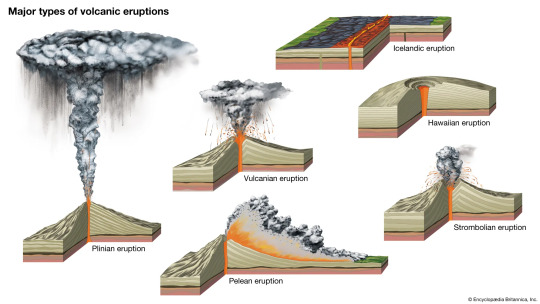
There are different types of volcanic eruptive events, including:
pyroclastic explosions, with is fast-moving hot gas and volcanic matter
hot ash releases
lava flows
gas emissions
glowing avalanches, when gas and ashes release.
Volcanic eruptions can also cause secondary events, such as floods, landslides and mudslides, if there are accompanying rain, snow or melting ice.
Hot ashes can also start wildfires.
Volcanic eruptions can impact climate change through emitting volcanic gases like sulfur dioxide, which causes global cooling, and volcanic carbon dioxide, which has the potential to promote global warming.
Features and Erupted Material
Viscosity: The resistance of a material (usually a fluid) to flow. Example of comparison would be the higher resistance to flow of cake batter compared to water.
Lava Flow: Lava flow is thin at the top of the cone, while lava pooled at the base is very thick. When eruptions end, erosion processes start on the cooled lava, including glacier erosion, flowing water, rockfall, and landslides. The volcano will only grow in size if the amount/volume of lava erupted is more than the amount that is lost to erosion.
Volcanic Gases: Most gases originate in the mantle and are transported to the crust and surface by complex interactions with magma and rocks along the way. In general, gases are dissolved in the magma. At shallow depths, as pressure on the magma decreases, gases leave the magma. The gases can interact with surrounding rocks or continue to the surface. The most common volcanic gases are: Water Vapor (H2O), Carbon Dioxide (CO2), and Sulfur Dioxide (SO2). Gases can be both dissolved in the magma chamber and also emitted from volcanoes at the surface. It’s the dissolved gases cause volcanoes to erupt.
A magma chamber contains high pressure and dissolved gases.
The density contrast between the magma and the surrounding rock causes more buoyant magma to rise. As the magma rises, the dissolved gases start to come out of the liquid and form bubbles.
As the bubbles grow and increase in volume, it causes the magma to became more buoyant and ascend closer to the surface, allowing the overlying pressure to decrease and produce magmatic foam.
When the pressure in the bubbles is greater than the pressure of the overlying rock, then the chamber will burst causing a volcanic eruption.
The viscosity, temperature and composition of the magma determine whether the explosion is explosive or effusive.
More Features and Erupted Material
Silica: Influences lava viscosity and overall shape of the volcano. Silica molecules form a strong bond that permits entrapment of volcanic gases and promotes explosive volcanic eruptions. Low-silican magmas allow rapid escape of gases and low-explosivity eruptions. Other factors that control magma viscosity include the temperature, gas, water content and the amount of crystals in the magma.
Color: Color and texture of lava vary considerably depending on cooling conditions. Lava rocks at high temperatures appear red to orange in color but cool quickly to shades of red (due to oxidation) and gray.
Sound: Witnesses of slow-moving, partially cooled lava flows report sounds similar to breaking of glass and pottery, caused by the splintering of the cooled outer skin of the lava flow. In contrast, the passing of a pyroclastic flow is eerily quiet. Some people say this is because its sound energy is absorbed within the billowing ash cloud.
Smell: Observers of lava flows report a slight sulfur smell in the air and the odor of burning vegetation.
Texture: Lava at Mount Rainier is not as fluid as lava at the volcanoes on Hawai'i, where lava flows sometimes resemble hot molasses, nor is it as viscous as lava at Mount St. Helens.
Tephra: Fragmental material produced by a volcanic eruption regardless of composition, fragment size or emplacement mechanism. Also referred to as pyroclasms (airborne), and pyroclastic flows (on ground) and rocks. Tephra can stay in the stratosphere for days to weeks following an eruption. It can also reflect light and heat from the sun back into the atmosphere. Tephra mixed with precipitation can also be acidic and cause acidic rain and snowfall. Tephra is made up of ash (fragments of pulverized rock, minerals and volcanic glass), volcanic blocks (a mass of molten rock), and lapilli (little broken up pieces of molten or semi-molten lava ejected from eruption).
Other Types of Volcanic Rock
If a rhyolite lava flow cools quickly, it can quickly freeze into a black glassy substance called obsidian. When filled with bubbles of gas, and usually with explosive eruptions, the same lava will form pumice. If the same lave is allowed to cool slowly…it will form a light-colored, uniformly solid rock called rhyolite.
Pumice most commonly forms with rhyolite lava flows, though it has formed from dacite and andacite. flows as well. It is so lightweight, it will float on water.
Obsidian has been used for centuries in many countries for things such as weapons and art.
The shape and size of a volcano are controlled by several factors
The volume of volcanic products
The interval length between eruptions
The composition of volcanic products
The variety of volcanic eruption types
The geometry of the vent
The environment into which the volcanic products are erupted
Overall, 44 volcanoes were in continuing eruption status as of 23 December 2024.
An eruption marked as "continuing" does not always mean persistent daily activity, but indicates at least intermittent eruptive events without a break of 3 months or more.
There are typically 40-50 continuing eruptions, and out of those generally around 20 will be actively erupting on any particular day (though detailed statistics on daily activity is not usually kept).
Health concerns after a volcanic eruption include:
Infectious disease
Respiratory illness
Burns
Injuries from falls
Vehicle accidents related to the slippery, hazy conditions caused by ash
When warnings are heeded, the chances of adverse health effects from a volcanic eruption are very low.
Volcanic Ash. Exposure to ash can be harmful. Ash is gritty, abrasive, sometimes corrosive, and always unpleasant. Small ash particles can abrade (scratch) the front of the eye. Ash particles may contain crystalline silica, a material that causes a respiratory disease called silicosis.
Sources: 1 2 3 4 5 6 7 8 9 ⚜ More: References ⚜ Writing Resources PDFs
Thanks so much! Do go through the links above for more details I wasn't able to include here. Hope this helps with your writing :)
#volcano#writing reference#writeblr#literature#worldbuilding#writers on tumblr#dark academia#spilled ink#writing prompt#creative writing#writing advice#writing inspiration#light academia#writing ideas#writing resources
76 notes
·
View notes
Text
Part 4 The Meaning of Flowers
Viktor x reader
Bridgerton AU
Warnings: olden times, sexism, light swearing, plus size reader, older Viktor, age gap, fat shaming, sexual, smut, oral F and M receiving, innocent reader, light corruption kink, reader in her 20s, long-haired Viktor, possessive Viktor, obsessive Viktor, angst
Previous part <-

Dearest reader it indeed seems that our duke, our man of progress is still not taking to any of the ladies this social season, a shame, but our next ball of the season is to be a grand one indeed hosted by the councilman and woman Talis at their large estate, it will indeed be a flurry of sunshine and gold amongst their grand home, they are known for their grand hosting once a year in the social season, a time for glittering lady’s and dark gentlemen, a true solar eclipse.
You were never one for the golden colours, But the Talis’s colour theme held tradition in the solar eclipse ball, a strange name you always thought but now you understand it with the ladies as golden suns and the men as dark as the moon, though in theory the moon is in fact bright and white, but who are you to question the council couple. Your mama had clawed her way to receive an invitation, while your papa remained blissfully unaware of her planning and scheming, she has indeed had a list of suitors to dance with you, no doubt having paid them a pretty penny so she can save the embarrassment of her daughter not dancing at all this social season. The gentlemen picked though are the worst amongst the city, A one Elias Hoskal, a horrid man and son of the councilman Toman Hoskal who indeed was also a horrid man. You suppose you should thank her for setting you up with someone so high up in society if only it weren’t for his massive debt and lack of… anything really. Another was Lord James Levi, a much older gentleman in need of a wife who you’d like to avoid touching at all given his appearance and constant stench. The only seemingly suitable one was Lord Clayton Chives, a man from a simpler upbringing and house but also simple in his mind. You didn’t tell your mama about your dance with the duke and man of progress, not sure how she’d react you’re not sure how anyone would react, and you’re not exactly sure how to react as well. Unsure if it was a jest you’re starting to see amongst the men when seeing you. If so you’re wondering how far your image would fall if you were indeed to steal a man’s cane and hit him with it.
The Talis’s estate is massive, surrounded by lush green land and gardens, the insides even more lavish than the outside accented with their colours of golds, purples, whites and reds, an odd choice of colours but they go well together. The ballroom though, was indeed another story, going on the eclipse, with golden walls and a black ceiling, the floor a design of gold swirls on black, it was gorgeous for sure, a little overwhelming most definitely. The left side of the ball had an array of drinks and foods, half you barely recognised and a grand accent in the middle of the room of assorted gold and black flowers. You’re too in awe to notice anybody else or the insistent push/pull of your mama’s hand around your arm. You spot the council couple staring at councilwoman Mel Medarda’s dress, a gorgeous gold that hugs her body at the top and flows down into a waterfall almost flaring out on the floor, she looks like a goddess. Her husband Councilman Jayce Talis next to her in a tight black suit and golden tie and a flower in his pocket. Then you see a third the duke, your breath intakes at the sudden difference between his usual, cream and red suits, a dark black suit much like the councilman only with a golden vest instead of a tie and flower. You think your brain struggles to process the look, his eyes practically matching his vest, his lack of cane and the way he stands almost confidently on his own, his hair long and tied back even more neatly though a long stray hair dangles down over his forehead and eyes. You’re not focusing on whatever your mama is saying to the lord in front of you, too focused on the ethereal three.
Your mama snaps your name in your ear and you look to her finally focusing on the gentlemen in front of you, internally grimacing at the look of the smirk on the councilman Hoskal’s son.
“My lord” you greet and he scoffs softly.
“Shall we?” He says holding his arm out like it’s a chore, then again it is, he’s getting paid to dance with you.
“The dancing hasn’t begun my lord” you say frowning and his famous scowl appears on his face.
“Keep your damn money I’m not dancing with some loud pig” he snaps and walks away. You feel something knocked in you from the insult and your mama begins to scold you. You barely make out the words your hands shaking lightly as you look at the floor.
“Ladies” it’s like a soothing balm of accented voice. You look up to the duke almost sighing in relief at the interruption.
“My duke” Your mama quickly regains composure and smiles bowing politely to the duke.
“May I have a word with your daughter?” He asks and your mama chuckles softly and nods walking off with a glare sent your way.
“I hope you will still honour me with a dance tonight?” He tilts his head ever so slightly as your eyes stare at his golden honeyed ones.
“My mother pay you?” You blurt without thought and he frowns faltering.
“No your mother did not pay me” he says.
“Then what? A dare from your friend?” You know you’re directing your anger at him, but everything seems too overwhelming at the moment, the colours the grandness the stuffy people.
“My lady I can assure you I’m offering you a dance because I want to” he steps closer his head bent to look at you directly, his fingers brushing against your chin to make you look at him.
“I’m sorry” you whisper nodding.
“Of course my duke I will honour your dance” you nod.
“The dancing has not begun, shall I bring you some lemonade?” He asks.
“That’s ok, you probably have people to talk with” you offer a small smile despite the shakiness in your hand.
“I’ve talked to everyone, except you my lady” he says.
“And you are indeed the most interesting” his voice lowers ever so slightly his accent thickening and it makes you gulp.
“I’ll be back with some lemonade” he nods and walks off. You notice his limp as he walks away and sighs a bit. He returns as he said, you thank him quietly forcing your hands to stop shaking as you take a sip of the cold refreshment.
“Ah, Viktor there you are” You look up noticing Councilman Jayce Talis walking over. He sees you, glances back to Viktor then smiles brightly making you frown ever so slightly.
“So I take it this is the young lady who finally swayed you to dance?” The councilman grins and you notice the red dancing across the duke's cheeks.
“Mind what you say Talis” Viktor clenches his jaw and Councilman Talis laughs.
“Councilman Jayce Talis and you are my lady?” He asks hand out. You take his hand give a small bow and introduce yourself he smiles and nods his head giving your hand a gentle squeeze before letting go.
“How do you like the party?” He asks and you glance around grimacing slightly.
“Given that face, I’ll say not very much” he chuckles.
“It’s a beautiful party, Councilman,” you say.
“But?” He doesn’t look offended in the slightest and your eyes flick to Viktor who gives a small nod.
“It’s a bit much for me councilman” you end up with.
“I see” he nods in thought.
“Well you’re not alone, it’s all rather, ridiculous if you ask me,” he says looking around and smiling when he sees his wife.
“Tradition seems to be a little too strong with my wife” he chuckles softly his eyes warm as he watches her before looking back to you.
“Well, next time I see you I will make sure to approach in less hectic circumstances” he bows his head and you do as well before he smiles at Viktor and leaves. You let a bit of tension leave your body as you sigh and finish your lemonade.
Music starts to play a gentle classical orchestra, you watch couples file to the dance floor black and gold, the solar eclipse. It’s truly beautiful to watch, the way the lady's dresses swish around almost like the way the sun has burning rays of lick, and the moons graceful yet strong in guiding the sun rays around. You notice a certain lord who your mother paid coming over and you panic.
“Dance with me,” you say to Viktor.
“Now?” he asks.
“Yes now” you glare taking his hand and practically dragging the poor man to the dance floor. He stumbles a bit as you put your arm on his shoulder and hold out your hand for him to take. He frowns a bit his gaze following yours, you watch him narrow his eyes and something darkens in his gaze as he puts his hand on your waist and grasps your hand. You go into the dance, the lord glaring at you both but stalking off making you sigh in relief. You look up to Viktor finally his honeyed colour eyes locking onto yours.
“I’m sorry my duke,” you say realising you dragged this poor man to the dance floor.
“You did honour me with a dance my lady” he chuckles lightly.
“I did, I just- did I hurt you?” You whisper and something in his gaze softens. He steps closer bringing your bodies almost chest to chest as you take in a breath.
“No” he whispers as he guides you around the dance floor. You’re very surprised the duke can dance at all given his condition. You notice a slight limp but it doesn’t stop him. Your gazes are locked together and suddenly you’re the only ones in the room, nobody else matters not even the orchestra. Your hands relax their tight hold and you allow yourself to feel his shoulder under your hand, you feel his strength in it, in his slender but calloused fingers. He twirls you around and brings you right back into his hold his warm hand splaying out against your waist. Nothing else matters at this moment, just you and him dancing. You barely hear the music dying down, the reality of couples slowing and the room coming back into focus. You blink a few times taking a shaky breath as he whispers your name.
“I’m sorry,” you say and leave quickly off the dance floor. You rush out to the gardens and feel your heart racing in your chest, sweat on your brow. You breathe heavily and your eyes gloss over. You hear your name being called but don’t register it till you feel those slender fingers in your arm. The duke saying your name but you can't hear it, you feel his fingers on your face forcing you to look at him.
“Breathe” it’s the first word you hear and you remember to breathe sucking in a deep but shaky breath.
“That’s it, deep breaths” he nods his honeyed eyes staring into yours. You feel so stupid, running out in a panic, tears well in your eyes and he does something unexpected. He wraps his arms around you, you breathe in the cologne he wears and a shudder goes through your body.
“Just breathe, follow my breathing” he says and you focus on the rise and fall of his chest trying to match it.
“That’s it” he whispers as you match his breathing and slowly feel yourself return to normal.
“Good girl” he murmurs atop your head and you can’t help the small intake of breath you do. You relax as much as you can, and coming back to normal, you realise you’re out in the garden alone with the duke who’s holding you.
“Viktor?” You hear a feminine voice and tense you go to move away but it’s too late.
“Mel” Viktor says as she stops frozen.
“Councilwoman Medarda” he slowly lets go of you bowing his head.
“May I ask what exactly is going on admits my garden?” She asks.
“She was having a panic attack,” the duke says.
“I see,” she says and nods.
“Mel-“ Viktor sighs and she holds her hand up before walking closer.
“Was I anyone else I would yell scandal, however” she smiles a bit.
“Councilwoman Mel Medarda” she holds her hand out to you and you freeze momentarily before holding her hand and introducing yourself.
“You two were quite the sight on the dance floor” She gives you a wink and you feel your cheeks warm.
“Mel” Viktor says in warning but she chuckles.
“Off with you Duke Viktor us ladies have things to talk about” You watch as she easily shoos the man away, his jaw sets but he gives you a soft look and leaves.
“Now that we’re alone, you needn’t worry my dear I won’t tell a soul” she says and you feel relief.
“You danced beautifully on the floor” she says and you feel your heart warm up at the compliment.
“Thank you Councilwoman” you nod your head.
“Please call me Mel when we’re alone, Councilwoman makes me feel so, official” she says and you smile a bit.
“A lovely smile as well,” she says and you feel embarrassment rise.
“Are you alright?” She asks her tone turning to concern.
“Yes, I think so- I don’t know what came over me” you sigh a bit.
“I know that look you two shared like nobody else was there on the dance floor. Not even the music?” She asks and you stare at her.
“Yes, it was-“ you chuckle a bit as she smiles nodding.
“There are few who can master the solar eclipse dance and you and Viktor did so beautifully” she says.
“I don’t think-“ she raises a hand silencing you.
“Did you know the duke spent a whole week, day in and day out learning that dance?” You frown lightly at her words.
“Of course, he didn’t tell you, men never tell women the length they go sometimes” she huffs.
“My husband Jayce made him a brace so he could dance, however, he was indeed lacking in the skills to dance, he was determined though to dance with you, so I taught him to dance,” she says.
“You taught him-?” You ask.
“First Jayce offered too but watching two men such as them dance is like watching two stones move together” You can’t help but laugh at her description imagining the duke and the councilman stiff as rocks.
“He was determined to dance with you though no matter how much he stumbled” she smiled warmly. Something in your heart flutters at her words knowing the duke went through a lot of effort just to dance.
“How would you like to join me for lunch tomorrow?” She asks and you look at her with wide eyes.
“Really?” You say shocked and she smiles nodding.
“I’ll have a carriage come get you, save you some hassle from your mama” she winks and walks back to the ball. You smile a bit a different kind of nervous flutter in your stomach. You return to the party instantly swarmed by a lord Levi.
“Ah there you are my dear, you owe me a dance” he grins and you instantly grimace at his yellowed almost brown teeth.
“She owes you nothing” Your eyes flick to the Duke.
“Excuse you? If I don’t dance with her I won’t get-“ Viktor glares at the man it’s unlike anything you’ve seen, it’s dark and narrowed and makes a lord instantly shut up apparently.
“Go” The lord runs off thankfully and you finally take a breath.
“Are you alright?” Viktor’s eyes soften as he looks at you and you nod thanking him quietly.
“I hope the councilwoman wasn’t forthcoming on you” he says in hushed tones and you chuckle a bit.
“She asked me to lunch tomorrow,” you say and his eyebrows go up slightly.
“Really?” He asks and you nod.
“How are you feeling about it?” He asks tilting his head ever so slightly.
“Nervous, but excited I’ve never-“ you hesitate a bit clearing your throat and realising your being a little too comfortable with the duke.
“Apologies my duke” You bow your head slightly and he frowns.
“What for?” He asks softly leaning in slightly, the conversation is only meant for you both.
“For being familiar with my duke” you nod avoiding his eyes.
“I see” he mutters standing up straight as one of the lords call his name.
“You should probably go to that” you say and cut him off before he can speak.
“Excuse me my duke” You bow your head and walk off sighing to yourself.
Next part ->
115 notes
·
View notes
Text
Take a deep breath...

X-ray images from our Chandra X-ray Observatory helped astronomers confirm that most of the oxygen in the universe is synthesized in massive stars. So, everybody say "thank you" to supernova remnants (SNRs) like this one, which has enough oxygen for thousands of solar systems.
Supernova remnants are, naturally, the remains of exploded stars. They're extremely important for understanding our galaxy. If it weren't for SNRs, there would be no Earth, no plants, animals, or people. This is because all the elements heavier than iron were made in a supernova explosion, so the only reason we find these elements on Earth or in our solar system — or any other extrasolar planetary system — is because those elements were formed during a supernova.
@nasachandraxray's data is represented in this image by blue and purple, while optical data from @nasahubble and the Very Large Telescope in Chile are in red and green.
Image description: The darkness of space is almost covered by the array of objects in this image. Stars of different sizes are strewn about, while a blue and red bubble of gas is at the center. An area of pink and green covers the bottom-right corner.
Credit: X-ray (NASA/CXC/ESO/F.Vogt et al); Optical (ESO/VLT/MUSE), Optical (NASA/STScI)
#space#nasa#universe#art#astronomy#science#galaxy#moon#stars#cosmos#spacex#scifi#astrophotography#photography#earth#astronaut#love#alien#nature#mars#spaceart#sky#spaceexploration#planets#aliens#spaceship#spacetravel#rocket#digitalart#design
58 notes
·
View notes
Text
Close to 18 years ago, astronomers spotted a miniature, icy world named Eris billions of miles beyond Neptune. But unlike its dwarf planet cousin Pluto — which New Horizons promoted to a rich, dynamic world after its visit in 2015 — Eris has not had any robotic visitors. It is so far away from Earth, in fact, that it shows up in observations just as a single pixel of light. All in all, scientists know very little about what happens on Eris. Though what we do know is Eris is known to have an atmosphere that freezes and snows onto the surface below, thanks to its place near the edge of the solar system. It's about 68 times farther from the sun than Earth is. And now, new models based on data from an array of radio telescopes in Chile have revealed more about Eris. Heat leftover from the dwarf planet's birth seems to be oozing out and slowly flexing its icy surface. The process is causing Eris to behave less like a solid, rocky planet and "more like a soft cheese or something like that," study co-author Francis Nimmo of the University of California Santa Cruz said in a statement. "It has a tendency to flow a bit." While a lot still remains unknown about Eris, it is considered an "almost perfect" twin of Pluto — both dwarf planets are nearly exactly the same size. Actually, when it was first spotted in 2005, it appeared to be slightly bigger than Pluto, triggering a debate among scientists. This had led the International Astronomical Union (IAU) to clarify its definition of a planet and demote Pluto to a dwarf planet. It was thanks to this contention in the scientific community that the IAU in 2006 named the dwarf planet Eris, after the Greek goddess of discord.
Continue Reading.
143 notes
·
View notes
Text
ASTRONOMERS HAVE DETECTED A NEW GRAVITATIONAL-WAVE??
Blog#316
Saturday, July 22nd, 2023
Welcome back,
After nearly two decades of listening, astronomers are finally starting to “hear” the rumbles of gravitational waves they believe emanate from the behemoths of our universe: supermassive black holes.
The result comes from a National Science Foundation–sponsored initiative known as the North American Nanohertz Observatory for Gravitational Waves (NANOGrav).

Since 2004 NANOGrav has monitored metronomelike flashes of light from a Milky Way–spanning network of dead stars known as pulsars. Forged from the hearts of exploding massive stars, these city-size orbs weigh as much as an entire sun and can spin thousands of times per second. This makes them remarkably accurate timekeepers—and ideal sentinels for the especially large ripples in spacetime predicted to emerge from merging supermassive black holes.
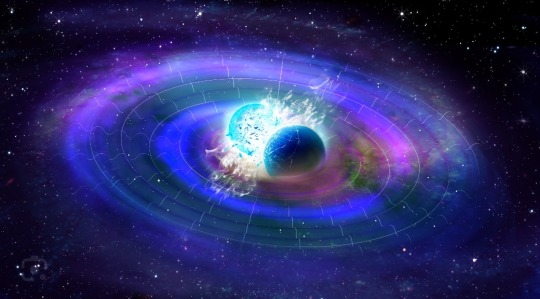
Such gravitational waves are distinct from the kinds that were previously reported from the Laser Interferometer Gravitational-Wave Observatory (LIGO) and other Earth-based detectors. For one thing, the waves spotted via pulsars wouldn’t all be traceable to individual merger events: they would form the so-called gravitational-wave background, the ambient rustling of spacetime built up from cumulative mergers throughout the cosmos.
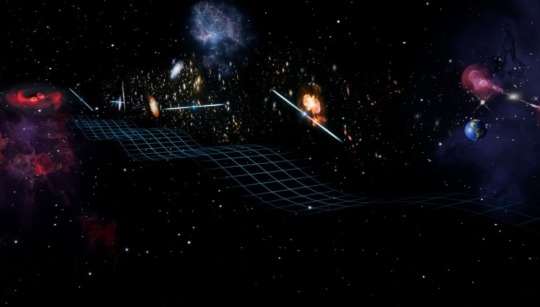
Another important distinction is that in their crest-to-trough span, each of these waves should be approximately the size of our solar system—which counterintuitively makes them much harder to detect. Washing over pulsar-strewn space, these gargantuan swells in spacetime could betray their presence via minuscule offsets to the dead stars’ spins, allowing observers to glimpse them through painstaking measurements. In a collection of five papers released today, that is essentially what NANOGrav claims to have done.

“It’s incredibly exciting because we think we’re starting to open up this new window on the gravitational-wave universe,” says Sarah Vigeland, an astrophysicist at the University of Wisconsin–Milwaukee and a member of NANOGrav.
(The collaboration’s work to date hasn’t quite met the statistical gold standard of how physicists evaluate the robustness of a finding.)

(So for now, scientists working on the project are modestly claiming “evidence for” the gravitational-wave background, not a full-fledged detection. But they’re confident that milestone will come with additional observations.)

NANOGrav is just one of several different pulsar timing array projects underway around the globe. All these endeavors follow the same basic blueprint: they use radio telescopes to monitor dozens of superpredictable pulsars for years on end to catch tiny variations in their rhythmic spinning.
Originally published on scientificamerican-com
COMING UP!!
(Wednesday, July 26th, 2023)
"WHAT IS STAR NIBIRU??"
#astronomy#outer space#alternate universe#astrophysics#universe#spacecraft#white universe#space#parallel universe#astrophotography
224 notes
·
View notes
Text


Cosmic anomaly hints at frightening future for Milky Way
A terrifying glimpse at one potential fate of our Milky Way galaxy has come to light thanks to the discovery of a cosmic anomaly that challenges our understanding of the universe.
An international team of astronomers led by CHRIST University, Bangalore, found that a massive spiral galaxy almost one billion light-years away from Earth harbours a supermassive black hole billions of times the Sun’s mass which is powering colossal radio jets stretching six million light-years across.
That is one of the largest known for any spiral galaxy and upends conventional wisdom of galaxy evolution, because such powerful jets are almost exclusively found in elliptical galaxies, not spirals.
It also means the Milky Way could potentially create similar energetic jets in the future – with the cosmic rays, gamma rays and X-rays they produce wreaking havoc in our solar system because of increased radiation and the potential to cause a mass extinction on Earth.
A re-think of galaxy evolution
"This discovery is more than just an oddity – it forces us to rethink how galaxies evolve, and how supermassive black holes grow in them and shape their environments," said lead author Professor Joydeep Bagchi, of CHRIST University, Bangalore.
"If a spiral galaxy can not only survive but thrive under such extreme conditions, what does this mean for the future of galaxies like our own Milky Way?
"Could our galaxy one day experience similar high-energy phenomena that will have serious consequences for the survival of precious life in it?"
In the new study, which has been published in Monthly Notices of the Royal Astronomical Society, researchers unravelled the structure and evolution of the spiral galaxy 2MASX J23453268−0449256, which is three times the size of the Milky Way.
Using observations from the Hubble Space Telescope, the Giant Metrewave Radio Telescope, the Atacama Large Millimeter Wave Array and multi-wavelength analyses, they detected an enormous supermassive black hole at its heart and radio jets that are among the largest known for any spiral galaxy, making it a rare phenomenon.
Traditionally, scientists believed that the violent activity of such colossal jets of supermassive black holes would disrupt the delicate structure of a spiral galaxy.
Yet, against all odds, 2MASX J23453268−0449256 has retained its tranquil nature with well-defined spiral arms, a luminous nuclear bar, and an undisturbed stellar ring – all while hosting one of the most extreme black holes ever observed in such a setting.
Adding to the enigma, the galaxy is surrounded by a vast halo of hot, X-ray-emitting gas, providing key insights into its history. While this halo slowly cools over time, the black hole's jets act like a cosmic furnace, preventing new star formation despite the presence of abundant star-making material.
How this compares to Milky Way
Our own Milky Way has a 4 million solar mass black hole – Sagittarius A (Sgr A*) – at its centre, but this is currently in an extremely quiet and dormant state.
That could change if a gas cloud, star, or even a small dwarf galaxy were to be accreted (effectively eaten), the researchers said, potentially triggering significant jet activity. Such events are known as Tidal Disruption Events (TDE) and several have been observed in other galaxies, but not in the Milky Way.
If large jets like this were to emerge from Sgr A*, their impact would depend on their strength, direction, and energy output, the researchers said.
One pointed near our solar system could strip away planetary atmospheres, damage DNA and increase mutation rates because of radiation exposure, while if Earth were exposed to a direct or nearby jet, it could degrade our ozone layer and lead to a mass extinction.
A third possibility is that a powerful jet could alter the interstellar medium and affect star formation in certain regions, which is what has happened in the galaxy the new paper focused on.
Astronomers believe the Milky Way likely had large-scale radio jets in the past and although it could potentially generate them again in the future, experts aren't able to say exactly when because it depends on many factors.
Dark matter clues
The team of researchers also discovered that J23453268−0449256 contains 10 times more dark matter than the Milky Way, which is crucial for stability of its fast spinning disc.
By revealing an unprecedented balance between dark matter, black hole activity, and galactic structure, the experts said their study opens new frontiers in astrophysics and cosmology.
"Understanding these rare galaxies could provide vital clues about the unseen forces governing the universe – including the nature of dark matter, the long-term fate of galaxies, and the origin of life," said co-author Shankar Ray, a PhD student at CHRIST University, Bangalore.
"Ultimately, this study brings us one step closer to unravelling the mysteries of the cosmos, reminding us that the universe still holds surprises beyond our imagination."
TOP IMAGE: The giant radio jets stretching six million light-years across and an enormous supermassive black hole at the heart of spiral galaxy J23453268−0449256, as imaged by the Giant Metrewave Radio Telescope. Credit Bagchi and Ray et al/Giant Metrewave Radio Telescope
LOWER IMAGE: Colour image of J23453268-0449256, which is 300,000 light-years across, as captured by the Hubble Space Telescope. It is shown alongside a depiction of our own Milky Way galaxy, which is three times smaller. Credit Bagchi and Ray et al/Hubble Space Telescope
10 notes
·
View notes
Text
Ko-fi prompt from Zarz:
Not sure if this is the type of question you're interested in, but if you are: My state has a cool energy efficiency program called Focus on Energy that sends people free LEDs and smart power strips, offers rebates for solar arrays, has discounts on smart thermostats, and runs various other programs to encourage saving energy. They advertise that the program saves over $4 for every dollar spent. Saving energy is great for the planet, but I'm curious how it also results in four-fold economic savings (and how in the world one would even begin to calculate an exact dollar amount for that).
So as a disclaimer, I have taken nearly a year to write this. It's not that the topic isn't interesting, it's just... really hard to research. But here's what I've got.
This is the sort of thing that is based on two kinds of evidence:
evidence of past cases where such a thing could be recorded and estimated
projected values based on estimates that come only from highly-controlled testing, but are only really 'in theory' so far
Solar panels are really popular right now, so we have a lot of case studies to look at. We also, at least in the US, have a pretty rigid utilities sector with near monopolistic control over pricing and access. Utilities in most places are, to my knowledge, negotiated by the local government, and then run privately.
But the first step to figuring out if a claim like you've heard up there is legitimate is to figure out what the base price of these things is.
I'll use Nassau County, New York, as an example, since it's nearby.
On average, Nassau County, NY residents spend about $245 per month on electricity. That adds up to $2,940 per year. That’s 35% higher than the national average electric bill of $2,179. The average electric rates in Nassau County, NY cost 24 ¢/kilowatt-hour (kWh), so that means that the average electricity customer in Nassau County, NY is using 1,041 kWh of electricity per month, and 12,492 kWh over the course of the year. Source: Energy Sage (link)
$245/month is our standard here for electricity on a 'standard' plan.
Let's assume we have no unexpected costs to cover in the first year, like hail damage or wildfire smoke. We just have the panels themselves and the installation costs.
This website, Solar Reviews, says the average cost after the federal tax credit is $11,500 - $14,056. Their cheapest estimate is the 4kw system, which is $9,322, but they say that the 6kw system is 'typical,' so we'll go with that, which is avg $12,778.
According to ecowatch:
On average, a 6 kW system will produce roughly 750 kilowatt-hours (kWhs) of electricity per month, or between 8,000 and 10,000 kWhs a year. (link)
New York has much less sunlight than a place like Arizona, so that's about 8,000 kWhs per year. It's about two-thirds of the amount of electricity the average resident of this county uses, meaning it covers about $2000 of electricity spending per year.
So, the average resident does not save money by installing solar panels of this size until they've had them for six years or so, and that's only if there aren't any major repairs. A resident with a really, really big expenditure and roof size, like a big box store, might see a greater return on investment since they'd be able to buy the panels themselves in bulk.
...but, that's without state or local rebate programs and the like. It might take less time for you to pay off the solar panels if you have those to rely on. That said, this Forbes article actually gives a higher estimate for using ROI to pay off the panels than I did, so it really falls into 'long term returns.'
(You can also manage to fuel an electric vehicle using just your solar panels, if you've got the money for one of those.)
#solar panels#ko fi prompts#ko fi#ko-fi#phoenix talks#taxes#tax credits#renewable energy#solar power
10 notes
·
View notes
Text
Cancelled Missions: Gemini Saturn V
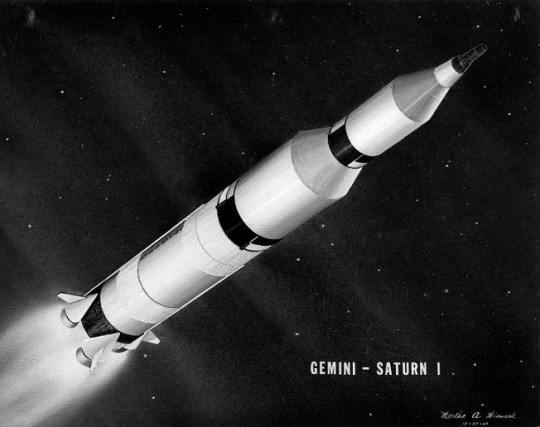
-Concept Art, however this has a typo, as this is clearly the Saturn V.
"American manned lunar orbiter. In l LP late 1964 McDonnell, in addition to a Saturn IB-boosted circumlunar Gemini, McDonnell proposed a lunar-orbit version of Gemini to comprehensively scout the Apollo landing zones prior to the first Apollo missions.
Status: Design 1964. Gross mass: 11,182 kg (24,652 lb).
The lunar orbit version required an Agena stage to provide the delta-V for lunar orbit insertion and trans earth injection. The 1.52 m-diameter Agena was enclosed in an inverted conical fairing to both transmit thrust loads to the Gemini and provide thermal protection during the coast to the moon.
Alternatively, a propulsion module based on a repackaged Apollo Service Module propulsion system, as had been proposed two years earlier for a lunar-landing version of Gemini, could be used. This raised the translunar injection mass of the spacecraft to 11,182 kg, well above the capability of a Saturn IB or Titan III-C, but only a quarter that of a Saturn V. The launch vehicle was unspecified, but could only have been a Saturn V used on an early test mission. The mission profile would have involved a 68 hour flight from low earth orbit to lunar orbit, a 24 hour lunar mapping mission in a 10 nm x 80 nm lunar orbit, and a 68 hour return flight. The scientific equipment would consist of a modest camera array installed in the nose of the spacecraft. This consisted of a long focal-length telescope, to which were attached two narrow-field stereo mapping cameras, a wide field mapping camera, a panoramic camera, and two 16 mm film cameras. The film was not accessible by the astronauts, being stored in a film vault shielded against radiation in the nose of the spacecraft. The camera compartment would protrude from the stub nose of the Gemini after parachute deployment.
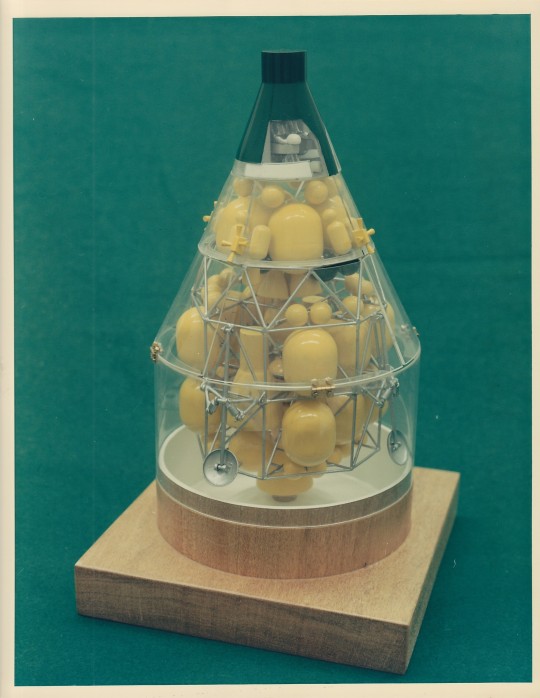
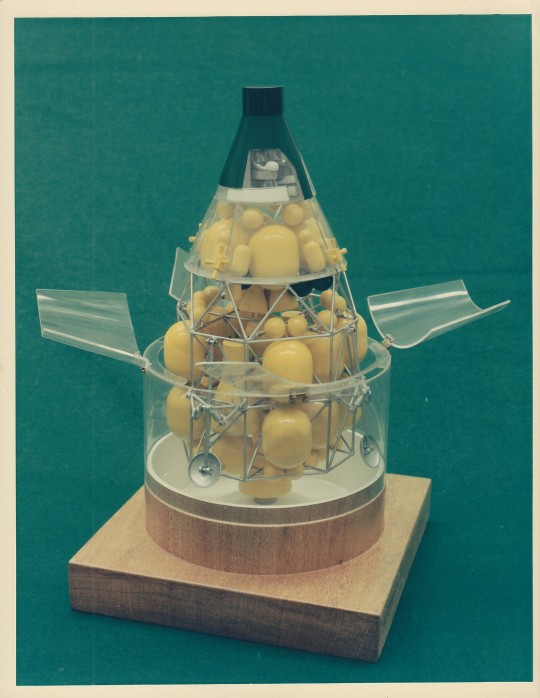
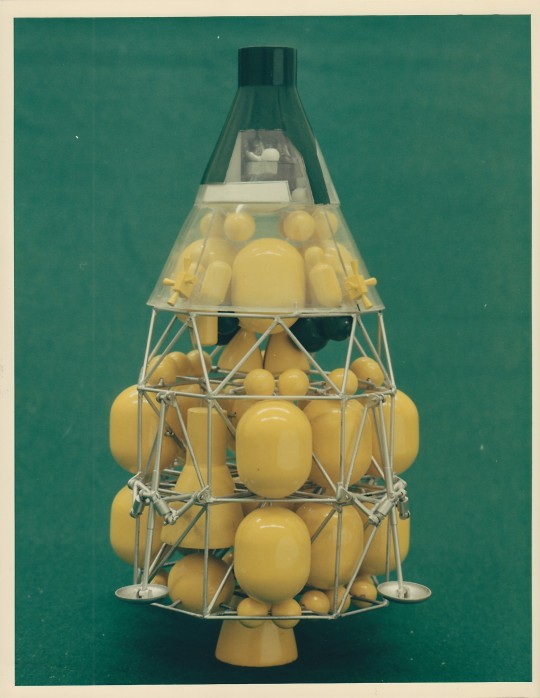
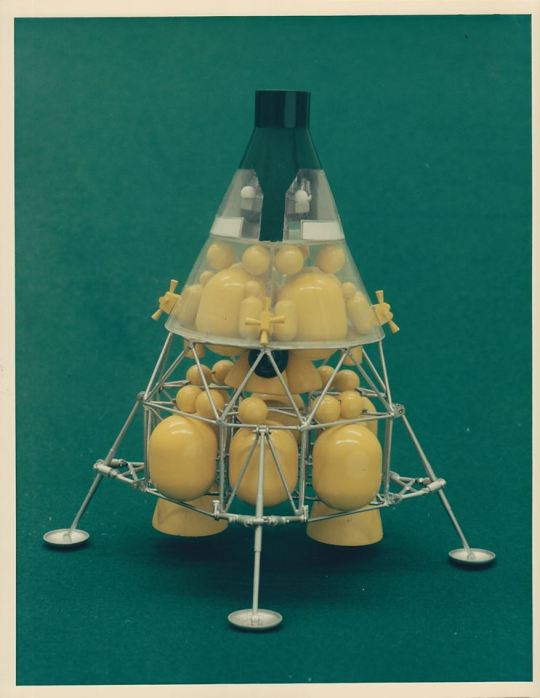
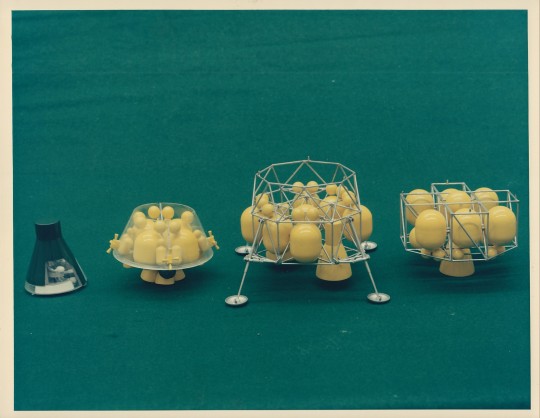
The manned portion was the same as the circumlunar version, a modified earth-orbit Gemini. The aft modules would be retained, but with the retrorockets removed. The retro module space would be used to install Apollo-type lunar distance communications, navigation, and test equipment. Deployable DSIF omni-directional and parabolic antennae would deploy from the aft modules to support lunar-distance communications. To handle re-entry from lunar distances, several modifications were necessary. The capsule's heat shield would be beefed up, and the Rene 41 corrugated shingles of Gemini's skin would be replaced with ablative shingles. The load of attitude control propellant for the capsule's reaction control system was substantially increased. Additional strap-down gyros and solar sensor packages would be added to provide navigation system redundancy. The ejection seats would be deleted and a Mercury-style launch escape tower added. The then-planned Rogallo wing recovery system would be used to glide to the Gemini to a runway landing on US territory after return from the moon. To handle the scientific payload, a camera compartment was added to the nose below the parachute/Rogallo wing housing. The Gemini spacecraft modified in this way had on on-orbit mass of 3955 kg as compared to the 3207 kg of the earth-orbit version.
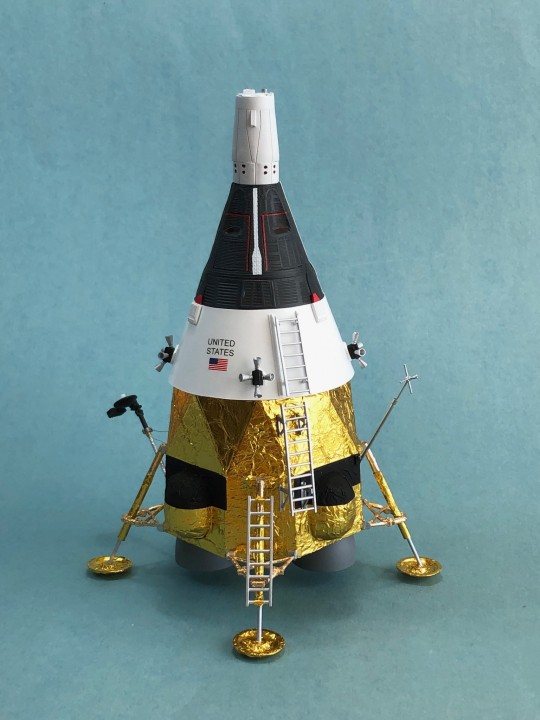
Crew Size: 2. Habitable Volume: 2.55 m3."
-information from Astronautix.com: link
source, source, source
#Gemini Saturn V#Gemini#Gemini Capsule#NASA#Gemini Program#Project Gemini#Saturn V#Rocket#concept art#artwork#cancelled#Lunar Gemini#1964#preliminary design#Cancelled Mission#my post
65 notes
·
View notes
Text
Closer than ever: It is now 89 seconds to midnight
In 2024, humanity edged ever closer to catastrophe. Trends that have deeply concerned the Science and Security Board continued, and despite unmistakable signs of danger, national leaders and their societies have failed to do what is needed to change course. Consequently, we now move the Doomsday Clock from 90 seconds to 89 seconds to midnight—the closest it has ever been to catastrophe. Our fervent hope is that leaders will recognize the world’s existential predicament and take bold action to reduce the threats posed by nuclear weapons, climate change, and the potential misuse of biological science and a variety of emerging technologies.
In setting the Clock one second closer to midnight, we send a stark signal: Because the world is already perilously close to the precipice, a move of even a single second should be taken as an indication of extreme danger and an unmistakable warning that every second of delay in reversing course increases the probability of global disaster.
In regard to nuclear risk, the war in Ukraine, now in its third year, looms over the world; the conflict could become nuclear at any moment because of a rash decision or through accident or miscalculation. Conflict in the Middle East threatens to spiral out of control into a wider war without warning. The countries that possess nuclear weapons are increasing the size and role of their arsenals, investing hundreds of billions of dollars in weapons that can destroy civilization. The nuclear arms control process is collapsing, and high-level contacts among nuclear powers are totally inadequate given the danger at hand. Alarmingly, it is no longer unusual for countries without nuclear weapons to consider developing arsenals of their own—actions that would undermine longstanding nonproliferation efforts and increase the ways in which nuclear war could start.
The impacts of climate change increased in the last year as myriad indicators, including sea-level rise and global surface temperature, surpassed previous records. The global greenhouse gas emissions that drive climate change continued to rise. Extreme weather and other climate change-influenced events—floods, tropical cyclones, heat waves, drought, and wildfires—affected every continent. The long-term prognosis for the world’s attempts to deal with climate change remains poor, as most governments fail to enact the financing and policy initiatives necessary to halt global warming. Growth in solar and wind energy has been impressive but remains insufficient to stabilize the climate. Judging from recent electoral campaigns, climate change is viewed as a low priority in the United States and many other countries.
In the biological arena, emerging and re-emerging diseases continue to threaten the economy, society, and security of the world. The off-season appearance and in-season continuance of highly pathogenic avian influenza (HPAI), its spread to farm animals and dairy products, and the occurrence of human cases have combined to create the possibility of a devastating human pandemic. Supposedly high-containment biological laboratories continue to be built throughout the world, but oversight regimes for them are not keeping pace, increasing the possibility that pathogens with pandemic potential may escape. Rapid advances in artificial intelligence have increased the risk that terrorists or countries may attain the capability of designing biological weapons for which countermeasures do not exist.
An array of other disruptive technologies advanced last year in ways that make the world more dangerous. Systems that incorporate artificial intelligence in military targeting have been used in Ukraine and the Middle East, and several countries are moving to integrate artificial intelligence into their militaries. Such efforts raise questions about the extent to which machines will be allowed to make military decisions—even decisions that could kill on a vast scale, including those related to the use of nuclear weapons. Tensions among the major powers are increasingly reflected in competition in space, where China and Russia are actively developing anti-satellite capabilities; the United States has alleged that Russia has tested a satellite with a dummy warhead on it, suggesting plans to place nuclear weapons in orbit.
The dangers we have just listed are greatly exacerbated by a potent threat multiplier: the spread of misinformation, disinformation, and conspiracy theories that degrade the communication ecosystem and increasingly blur the line between truth and falsehood. Advances in AI are making it easier to spread false or inauthentic information across the internet—and harder to detect it. At the same time, nations are engaging in cross-border efforts to use disinformation and other forms of propaganda to subvert elections, while some technology, media, and political leaders aid the spread of lies and conspiracy theories. This corruption of the information ecosystem undermines the public discourse and honest debate upon which democracy depends. The battered information landscape is also producing leaders who discount science and endeavor to suppress free speech and human rights, compromising the fact-based public discussions that are required to combat the enormous threats facing the world.
Blindly continuing on the current path is a form of madness. The United States, China, and Russia have the collective power to destroy civilization. These three countries have the prime responsibility to pull the world back from the brink, and they can do so if their leaders seriously commence good-faith discussions about the global threats outlined here. Despite their profound disagreements, they should take that first step without delay. The world depends on immediate action.
It is 89 seconds to midnight.
8 notes
·
View notes
Note
I keep thinking about the astrography of the Koboh system and I'm wondering if anyone's got any clear answer on on how Koboh, its moon, and Tanalorr/the Abyss behave in relation to each other. Can I ask what you think?
Because for the arrays to work, that specific part of Koboh and the part of the moon with the station both have to be facing Tanalorr. And of course they have to be close enough: Tanalorr can't have its own orbit like Mars or most of the time it'll be way across another part of that solar system, so I figure they've got to be binary planets, orbiting around each other and moving together around their star.
And, given that we see the Abyss in the sky over Ramblers' Reach in both daytime and nighttime, they've got to be tidally locked, or at least Koboh does. Otherwise you'd have to wait to activate the array until Koboh's orbit has come back around to face the Abyss at whatever time of day that is, and I don't think we say the Abyss move round the sky much, right?
So all that can be explained… but then I've got to wonder: How the hell can anyone, Empire idiots or otherwise, see a giant planet-size nebula spining around Koboh in a stable orbit, a nebula with the same gravitational pull as a planet, and NOT wonder "hey, what if there's something planet-sized in there?"
I know the answer is handwavey plot necessities and I'm overthinking things, but… there could be some interesting plotbunnies in there.
Has there been any talk about this anywhere that you've heard?
As always, love your work! <3
You are way, way, WAY smarter than I am. Wow!Just let me bask in your genius for a moment.
You're right - I don't think the Abyss moves... and oh, how I wish we could explore Koboh at night throughout the game!
I did mention in a "what do I want in Jedi 3" post a while back that Tanalorr is going to have to come under some kind of existential threat in the next game because all stories need jeopardy. We know the Empire is on Koboh and there's an entire Star Destroyer in the sky in the post-game of Survivor. They don't appear to be searching for anything in particular (I may have missed it, but I don't think the troopers say "hey, I hear that Jedi terrorist is lurking here somewhere!" unlike literally every Raider) so I don't think they're there for Cal specifically. More like Koboh's the next world on their galactic conquest. However, it's likely that the more they see, the more they will explore. We know from JFO that Palpatine wants relics of other Force cultures, so maybe he'll show an interest in what was left behind on Koboh...
We also know from the game's finale that the arrays overload and now the only way to get to Tanalorr is to 1) be a damn good pilot, and, 2) be a Jedi, or have one very close by, or 3) have a compass. So there's a really good chance that, with the Empire having a presence on Koboh, they'll notice all the comings and goings through the Abyss and start exploring... and exploding. You have to imagine initially Cal and co will be able to rely on anyone following them in getting 'sploded by the Koboh Matter, but what if someone gets lucky, gets through, and does find Tanalorr and alerts the Empire??? There's your jeopardy.
I hope they have lots of ships of Tanalorr and plenty of people to repaint them regularly to make the Empire think anyone going in there is also dying because they never see the same ship twice...
This is fun to think about!!! And makes me curious to know what the final game will do with this. Maybe it'll be a case of they decide to seal off Tanalorr for the safety of those there.... Maybe Cal does that and he stays behind... Maybe, maybe, maybe...
Thanks for the Ask, and the kind words! I better get back to some writing!!
11 notes
·
View notes
Text
About That Big Solar Power Plant …
Meanwhile, Sunly has not let the grass grow under its feet. Last week the company rolled out its first project under the new financing, a 244-megawatt solar power plant located in Risti, in Lääne County. A 144-megawatt battery array will complement the solar panels, and Sunly is in discussions with local communities to determine the location of nine wind turbines.
At 244 megawatts, the size of the project is a giant step up for Estonia. The current record holder for solar power plants in the country is the 77.5-megawatt Kirikmäe Solar Farm in Pärnu County, which started operating in October. The Kirikmäe project more than doubled Estonia’s installed solar capacity in one blow. Now here comes the Risti project, which is more than triple the size(..)
#Estonia#energy independence#energy safety#solar power#wind power#renewable energy#demise of big oil#russian defeat#Baltic States#Northern Europe#Latvia#Lithuania#NATO#trump's defeat
5 notes
·
View notes